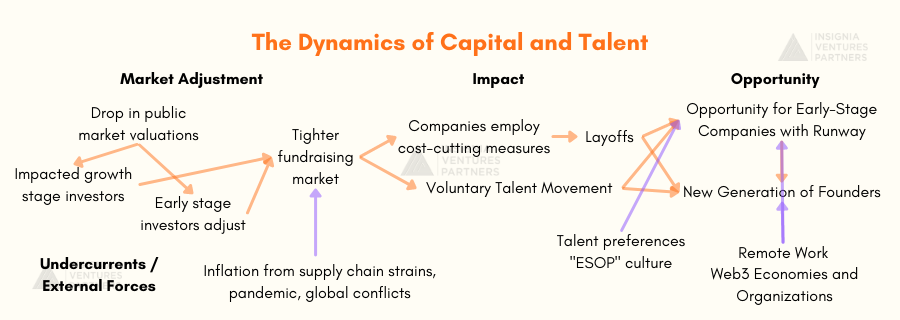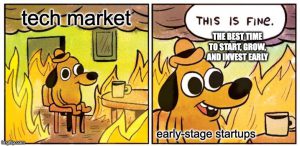Highlights
- Enduring and thriving in market adjustment is not just a result of cost-cutting but also of seizing growth opportunities that others may overlook because of the current environment.
- The drop in valuations of companies in the public markets has reduced the buying power of growth-stage investors, causing earlier-stage investors to take a step back in terms of selecting companies they are well-positioned to ferry towards growth. Finally the tightened belts of investors force companies with business models dependent on a consistent pump of external capital to make tough cost-cutting decisions. Among these decisions are employee layoffs.
- Whether it is from growth stage to early-stage or from Silicon Valley to the rest of the world, there is a democratization of talent flows, and this could be further sustained with increasing openness to remote work opportunities and the emergence of web3 economies.
- It is also likely that people costs may be shifted more towards investing in employee retention (e.g. ESOP is just one way) as it becomes more costly (in terms of both time and money) to bring in fresh talent rather than keep employees or even leaders who have already acclimatized and are adept in their roles.
- We see two generations of mafia being formed through investors and startups taking advantage of these shifts in talent, an earlier one looking to already start their own companies and one that becomes mafia through their own growth in an existing early-stage startup.

The pandemic impact on fundraising in 2020 came as a shock but carried with it a shift in digital adoption that ultimately benefited many tech companies. On the other hand, the roots of this fundraising winter in 2022 are more directly tied to the nature of how tech companies have been funded both in the public and private markets.
Even in late 2019, pre-pandemic there were already shifting investor sentiments (i.e. the whole “flight to profitability”, which we wrote about and included in the book Navigating ASEANnovation). The macroeconomic conditions from the pandemic to the armed conflicts globally impacting supply chains and inflation in 2022 were simply a lit match.
At the same time, as we wrote recently in our newsletter, the last thing to do in this “storm” is to stay still. “It is during these harsh (and often sequential) market adjustments that enduring companies are minted by stronger business fundamentals and rapid movements in resources (capital and talent).”
Companies that will endure and even thrive are those that are able to create flexibility and optionality in their cash flow, whether by a longer runway or simply healthy margin businesses. That isn’t just a result of cost-cutting but also of seizing growth opportunities that others may overlook because of the current environment.
One such opportunity revolves around tapping into talent opportunities that have come as a result of the reshuffling of talent across borders. In this article we dig deeper into the changing flows of talent, sharing insights from interviews with DealstreetAsia, parts of which were also quoted in these articles on “Indonesian startups downsize to cut costs amid global headwinds” and “Startups in Asia brace for harsh winter as layoffs keep piling up.”

House of Cards
The reshuffling of talent has manifested in massive layoffs across all stages of tech companies, both in the private and public markets. The public market slumps, the shifts in investor sentiments, and even the “scale-at-all-costs” business models are all part of this house of cards, and layoffs from companies even private investor-backed early-stage ones are part of this domino effect of these cards falling one after another.
Specifically, the drop in valuations of companies in the public markets has reduced the incentives and buying power of growth-stage investors. This in turn is causing earlier stage investors to take a step back in terms of selecting companies they are well-positioned to ferry towards growth, especially in light of how much pricier the market has been over the past year.
Then finally the tightened belts, even of earlier-stage investors, force companies with business models dependent on a consistent pump of external capital to make tough cost-cutting decisions. Among these decisions are employee layoffs. Companies able to float for a longer period without capital injection in a dry fundraising environment are less likely to resort to more extreme cost-cutting measures, and these are often companies already producing gross profit or profitable unit economics.

Democratization of Talent
As the impact of tech companies’ public market slump seeps further into the private market value chain, we may see more talent shifting from growth companies to earlier stage companies, especially as some of the former find it more difficult to raise larger rounds on top of valuations priced prior to the slump.
We’re already seeing a number of these layoffs in US big tech companies that were hit most severely paired with a scaling back of certain operations. We can expect to hear more of these as the market unfolds and some companies are forced to resort to extreme cost-cutting measures to relieve pressure.
This presents a massive opportunity for startups in Southeast Asia to recruit talent who have experiences and skills of having seen companies go through growth stages or go public and bring in such insight into their own businesses.
Whether it is from growth stage to early-stage or from Silicon Valley to the rest of the world, there is a democratization of talent flows, and this could be further sustained with increasing openness to remote work opportunities and the emergence of web3 economies that are less likely to require specific locations for their workforce.
Some lists of talent flow / layoff trackers that maybe useful to narrow down talent searches:
- Layoffs.fyi
- Trueup.io/layoffs
- Indian Startup Layoffs Tracker by Inc42
- Tracking layoffs across Asia’s startup ecosystem by Tech in Asia
- 2022 startup layoff tracker by TheOrg

Creating flexibility and optionality around people
Compensation may be impacted as well overall as companies seek to lengthen runways in the short term as they secure more financing. This puts early-stage companies that are able to secure cash and/or already have a business model with good margins in prime position to be on top of the list for the best candidates. These companies have a greater luxury of being able to create more options and really find the right fit for their needs.
We write about other cost-cutting methods in this article
“It is also likely that people costs may be shifted more towards investing in employee retention as it becomes more costly (in terms of both time and money) to bring in fresh talent rather than keep employees or even leaders who have already acclimatized and are adept in their roles,” as quoted on DealstreetAsia.
ESOP is part of the equation for retention but it’s likely not as dominant of a factor in Southeast Asia, “especially in markets where not as many companies have yet reached that point of delivering returns to their employees, or where the workforce may not be as familiar with ESOPs,” as quoted on DealstreetAsia.
It may play a larger role for employees who have already experienced ESOP agreements before or have been with the company from its early days, and so they are in a better position to assess whether their ESOP is worth staying for.
In a market where the cost differential of filling in positions as opposed to retaining talent is higher and where valuations and therefore the potential gains of ESOPs are impacted, growth companies can’t solely depend on ESOP when it comes to retaining employees.

Lubricant to fill in gaps for early-stage startup maturity
Regardless of the season, most early-stage startups will try to secure leaders for positions one or a few levels higher than their current position at a bigger firm, depending on their ability and the nature of the role. For example, hiring a VP-level leader from a bigger firm to take on a C-level role in a smaller, but say faster-growing firm.
And for early-stage startups, a common gap we see in people is the lack of operational leaders or those who are able to introduce structure, processes, and maturity into a hypergrowth organization, whether it’s in terms of finance, operations, or even talent.“So this market correction could be a lubricant for what is already a difficult hiring task for these startups,” as quoted on Dealstreet Asia.
There may be less resistance for such top-level management to make the switch, especially if the role they are switching to matches their expectations.
Of course how much of a lubricant it will prove to depend from person to person. Not all professionals coming from leadership roles in growth-stage tech companies would have the same level of interest in pursuing a role in an earlier-stage company. There’s not only the question of cash compensation but also handling hypergrowth.
The probability to fit in a hypergrowth culture is higher for leaders who have been with these growth-stage companies since early on and are looking for the next stage in their career, but “sunk cost bias” or “loyalty” may be a source of friction in making the decision to transition.
We’ve covered some of these transition stories from growth-stage or first-generation unicorn companies to fast-emerging tech leaders on our podcast and spinoff series A Leader A Minute, as in the case of Super Head of HR Nabil Ishak who came from Bukalapak, Flip VP of Product Management Sourabh Gupta who came from Gojek, or even Brankas Group Product Manager Marolop Siagian who came from Xendit.
A Leader A Minute E5 with Nabil Ishak
@vcinsider “HR is not the icing on the cake, but the baking powder. It can spell the difference between scaling or not.” @aplikasisuper head of #HR Nabil Ishak #podcast #leader #people #talent #hiring #fyp ♬ original sound – The VC Insider
A Leader A Minute E1 with Sourabh Gupta
@vcinsider A Leader A Minute: a mini-series on the #podcast featuring #startup #leaders and #jobs! First is Sourabh, VP of #Product #Management at @flip_id #fyp ♬ original sound – The VC Insider
A Leader A Minute E7 with Marolop Siagian
View this post on Instagram
Way of the Tech Mafia
There are two long-term, ecosystem-wide opportunities here beyond filling in key roles, though it would be amiss to say they are entirely motivated by talent losing interest in their ESOP.
First is that there is an opportunity for venture capitalists or even angel investors to be able to spot and support a new wave of senior leadership leaving tech companies to start their own ventures. In times of market pricing corrections, there is actually more to be found in companies that are just starting out, where the growth potential, even just from a valuation standpoint, is greater coming out of a bear market. In particular, this phenomenon may be more prevalent among professionals coming from Silicon Valley returning to Southeast Asia.
Second is that there is a greater opportunity for early-stage startups to recruit these leaders early on in the life of their company and potentially groom their entrepreneurial mindsets and capabilities, where they may relatively not have had as much room to explore these aspects in larger organizations. The reality that some talents are willing to take the risk of joining an early-stage startup amidst a bear market already points toward a certain predisposition towards entrepreneurship.
As we write in this article on the GoTo mafia, “While it’s clear that these alums have taken away a lot from their experience at Gojek and Tokopedia, it’s important to note that they were also already learning on the go at these very companies and would not have been able to do this, much less apply it elsewhere if it not for their working environments and the mindsets they brought into the company. In essence, they already had that entrepreneurial mindset and founder spirit even working in these companies. So the question is, “How do you create a culture of future founders? How do you make your own mafia?””
So we see two generations of mafia being formed through these shifts in talent, an earlier one looking to already start their own companies and one that becomes mafia through their own growth in an existing early-stage startup.

Paulo Joquiño is a writer and content producer for tech companies, and co-author of the book Navigating ASEANnovation. He is currently Editor of Insignia Business Review, the official publication of Insignia Ventures Partners, and senior content strategist for the venture capital firm, where he started right after graduation. As a university student, he took up multiple work opportunities in content and marketing for startups in Asia. These included interning as an associate at G3 Partners, a Seoul-based marketing agency for tech startups, running tech community engagements at coworking space and business community, ASPACE Philippines, and interning at workspace marketplace FlySpaces. He graduated with a BS Management Engineering at Ateneo de Manila University in 2019.